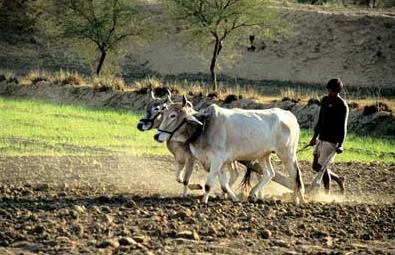Conservation tillage systems are methods of soil tillage which leave a minimum of 30% of crop residue on the soil surface or at least 1,000 lb/ac (1,100 kg/ha) of small grain residue on the surface during the critical soil erosion period. This slows water movement, which reduces the amount of soil erosion; it also warms the soil, enabling the next year’s crop to be planted earlier in the spring. Conservation tillage systems also benefit farmers by reducing fuel consumption and soil compaction. By reducing the number of times the farmer travels over the field, farmers realize significant savings in fuel and labor. Conservation tillage was used on about 38%, 109,000,000 acres (440,000 km²), of all US cropland, 293,000,000 acres (1,190,000 km²) planted as of 2004 according to the USDA.
* No-till
* Strip-Till
* Mulch-Till
* Ridge-Till
[edit] General comments
* The type of implement makes the most difference but other factors can have an effect. The table in this publication gives some idea of the amount of residue that might be left with different tillage operations.
* The greater the speeds with which you move some tillage implements (disks and chisel plows), the more intensive the tillage (ie., less residue is on the soil surface).
* Increasing the angle of disks causes residues to be buried more deeply. Increasing their concavity makes them more aggressive.
* Chisel plows can have spikes or sweeps. Spikes are more aggressive.
* The reason the percent residue is used to define tillage systems is that the amount of crop residue impacts the amount of soil loss due to erosion. This graph demonstrates the amount of soil that might be expected to be lost with different amounts of crop residue.
* Look at this reference to see how to measure crop residues.
* In the same reference as above you can see what different amounts of corn and soybean residue look like.
General Greenhouse Management
Greenhouse Construction
Climate Control in GH Structures
Greenhouse Management: Soil Sterilization and preparation, cultural practices in flower and vegetable cultivation
Irrigation and Fertigation Technology
Crop Protection
Post Harvest and Marketing
Ergonomics

Marketing of Horticultural Produce
Importance and Scope
Post-Harvest and Handling
Marketing Channels
Domestic & Export Marketing : Potential Markets & Procedures
Logistics and Planning
Marketing of Allied Products
Post-Harvest and Handling
Marketing Channels
Domestic & Export Marketing : Potential Markets & Procedures
Logistics and Planning
Marketing of Allied Products
FUNDING SCHEMES
Bank of Maharashtra
Minor Irrigation for Agriculturists scheme for purchase of various irrigation equipments.
Mahabank Kisan Credit Card scheme for cultivation of crops, meeting the short-term credit needs of farmers.
Farm Mechanisation for Agriculturists scheme for Purchase of Tractors/Power tillers, Harvesters, Threshers & other farm
implements.
Animal Husbandry scheme for Purchase of animals, Poultry- Broiler Farm, Layers Farm, Hatchery Sheep/Goat Rearing Construction
of Byre, and Purchase of Machinery Working Capital Requirements under
Scheme for Cultivation of fruit crops-mango, Pomegranate, Grapes etc.
Scheme for providing finance to set up of Agri-Clinics/Agribusiness Centers.
Scheme for Financing Farmers for Purchase of Agricultural land.
Scheme for Financing Two Wheelers to Farmers
Scheme for Providing Loans to Farmers for Purchase of consumer durables
Scheme for Hi-tech projects in agriculture.
Rural Godown Scheme (Gramin Bhandaran Yojana) for scientific storage of agricultural produce.
Minor Irrigation for Agriculturists
Purpose :
Digging of new wells, revitalization of existing well, purchase of oil engine, electric motor, pump set installation of pipe line, sprinkler, irrigation, drip irrigation, tube well, bore well, etc.
Eligibility : Agriculturist who owns agricultural land.
Amount : For new dug wells as per the NABARD Unit costs for equipments/estimates.
Repayment : Depending upon the repaying capacity 7 to 11 years.
Security : Mortgage of land, Hypothecation of movable assets and guarantors.
Other Terms & Conditions :
Proposed well should be located in white watershed area. It should not be in dark watershed area.
Minor Irrigation for Agriculturists scheme for purchase of various irrigation equipments.
Mahabank Kisan Credit Card scheme for cultivation of crops, meeting the short-term credit needs of farmers.
Farm Mechanisation for Agriculturists scheme for Purchase of Tractors/Power tillers, Harvesters, Threshers & other farm
implements.
Animal Husbandry scheme for Purchase of animals, Poultry- Broiler Farm, Layers Farm, Hatchery Sheep/Goat Rearing Construction
of Byre, and Purchase of Machinery Working Capital Requirements under
Scheme for Cultivation of fruit crops-mango, Pomegranate, Grapes etc.
Scheme for providing finance to set up of Agri-Clinics/Agribusiness Centers.
Scheme for Financing Farmers for Purchase of Agricultural land.
Scheme for Financing Two Wheelers to Farmers
Scheme for Providing Loans to Farmers for Purchase of consumer durables
Scheme for Hi-tech projects in agriculture.
Rural Godown Scheme (Gramin Bhandaran Yojana) for scientific storage of agricultural produce.
Minor Irrigation for Agriculturists
Purpose :
Digging of new wells, revitalization of existing well, purchase of oil engine, electric motor, pump set installation of pipe line, sprinkler, irrigation, drip irrigation, tube well, bore well, etc.
Eligibility : Agriculturist who owns agricultural land.
Amount : For new dug wells as per the NABARD Unit costs for equipments/estimates.
Repayment : Depending upon the repaying capacity 7 to 11 years.
Security : Mortgage of land, Hypothecation of movable assets and guarantors.
Other Terms & Conditions :
Proposed well should be located in white watershed area. It should not be in dark watershed area.
